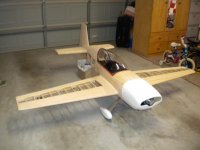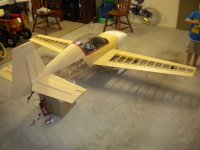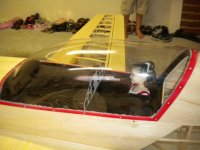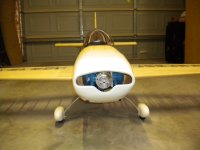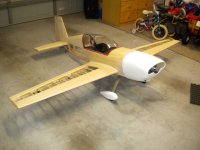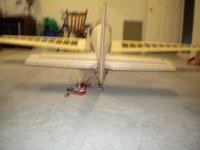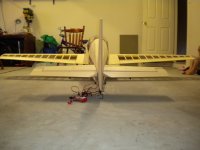Sorry folks, late to this thread, but as you can see from my avatar, I have this exact same aircraft. It took me four years on and off to build it, but it has been flying for about eight years and two motors now. Just thought it might be nice to address some of the issues that have been raised (although I am too late to offer advice on some as you are already past that point).
The quality of the kit is not great, being that it is mostly die cut (and I think I got mine towards the end of the run where there was more compression cutting than actual cutting of some parts). The quality of the sheeting throughout was poor and the matching was even worse. I took the time to match left to right and top to bottom to ensure no twisting of the build. You also need to get the softest sheet for the centre of the top fuselage sheeting otherwise it will split and cause all sorts of issues.
Some things I noted from my build:
- The AUW of mine initially was 11.75kg (25.85lb). I flew it on a Fuji BT-86 Twin magneto setup. Not lots of power but would do all the basic aerobatics bar snaps on the upline. I have since upgraded to a Hobby King 111cc (essentially a DLE-111 V2) and it is much more sprightly, just had to move some batteries forward to get the CG correct.
- I stuck with using the bolts through the joiner tube to keep both the stabs and wings on. I have never had an issue with this. I remove the stabs for transport and storage to avoid hangar rash.
- I chose to add the counterbalance to the rudder and in my opinion it adds the brilliant knife edge that this aircraft is capable of. I can easily go the length of the field on its side with minimal elevator or aileron compensation.
- I noted that you were concerned with the bevels only being on the aileron and not the back of the wing. I stuck with the kit on this and I was able to get plenty of throw and it is quite spritely with the amount of throw you can get.
- I used two aileron servos per aileron to avoid the issue of the aileron flexing. The stock size aileron does allow plenty of authority though, so I would have suggested that you not add the additional 1" to it.
- While I like the modifications that you made to the wing, you don't really need them. I stuck with the kit design and have never had an issue, even after putting quite some stress on them through some of my flying. As I said above, I have been flying mine for about eight years and it has been my go to plane for most of that so has been very well used.
- In regards to the wing tube, it does not go all the way out to the end of the wing tubes. Utilising the bolts through the tubes ensures that it cannot slide around so there is no issue with it moving in flight. As you have chosen an alternative method of keeping your wings on, I would suggest that you update to a tube that does go the full length so you get an even distribution of stress in both wings and the tube does not slide around.
- In regards to the right thrust in the firewall, I built mine with it included and have never had an issue, even across two different motors. I do not have to program a throttle to rudder mix to deal with it which simplifies the set up. Down thrust is a personal choice, but I included it and do not regret it.
- I covered mine entirely in monokote.
Happy to provide some other thoughts as you go through the fuselage build.
My current set up is (noting the age of the aircraft):
Hobby King 111cc (cheap, but runs well and as I am not into IMAC it is plenty to undertake basic 3D, inverted flat spins being a favourite)
Smart-Fly Power Expander with fibre optic ignition kill switch (Has the regulator and servo matching)
2 x 3000mAh 2S LiPo receiver batteries
1 x 1800mAh 2S LiPo ignition through a voltage regulator
2 x JR DS8611 for the rudder, mounted in the rear of the fuselage
2 x JR DS8611 for each aileron
1 x JR DS8611 for each elevator half
1 x JR DS811 for the throttle
Here is a photo of the completed, but uncovered aircraft with my son in the background.

 I just knew that fire wall question was "LOADED". Pun intended Snoops
I just knew that fire wall question was "LOADED". Pun intended Snoops  .
.
